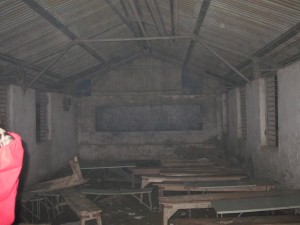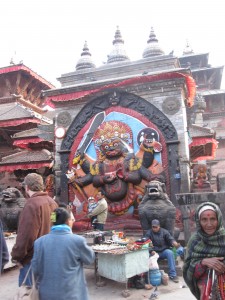Today, we were able to see, first-hand, the conditions and hard-ships of living in a rural village in Nepal. In the district of Bara in southern Nepal near the Indian border, we visited a remote village and were able to see how the people live.
We arrived in the village in the late afternoon, our jeeps barely able to drive through the narrow dirt roads lined with huts and crowded with children, chickens, goats. There were a few bicycles and the occasional motorbike, but it was clear that not many cars passed through, especially not ones filled with foreigners. Our cars pulled up to two story, decrepid school building in a large field in the middle of one of the villages; there was a large group of men crowding around to see what our purpose was there. One of the men greated us with little orage flowers, an although the children had gone home for the day, they had anticipated our arrival by writing “welcom” in Nepal by the entrance of the school. We were given a tour of the school where we learned that hundreds of children were in attendence. The building was in poor shape, and the classrooms were dirty and filled with broken benches; we were told that in some of the larger classroom, over 200 students attenden class each day. I cannot imagine trying to learn, or teach, in that kind of environment. The pre-school was nothing more than a tree-sided structure with a dirt floor; we learned that the homeless often slept under the crude shelter, and were allowed to do so as long as they cleaned up and were gone in the morning by the time the children came.

Next, we walked through one of the near by villages, accompanied by what seemed to be a village elder. He showed us his home, a small, mud hut, and showed us what his wife was cooking for dinner- some rice and a small amount of vegetables for 5 people. It was getting dark, and fired glowed outside every hut as women prepared meager meals of mainly rice; small children warmed their bare fingers and toes on slow-burning ashes. We spoke to one woman, who looked much older that she likely was, thanks to a life of work, poverty and hardships. She worked on a plot of farm land, and was paid not in cash, but in bags of rice; If she took two bags home, she would have to repay the landlord with four- she was, essentially, trapped in a system of bonded labor. She worked 10-12 hours a day to feed 8 mouths.
It was an unbelievable experience to see this state of living, especially at night, when the cold, the lack of electricity, and the lack of basic needs was most prevelent.



 This last experience of the physical beauty Nepal has to offer was a great way to remember and appreciate all that we have seen; but we must not forget that Nepal is still a country struggling to rebuild after war and, like the bumpy, windy roads we travelled on, there is still a tough journey ahead.
This last experience of the physical beauty Nepal has to offer was a great way to remember and appreciate all that we have seen; but we must not forget that Nepal is still a country struggling to rebuild after war and, like the bumpy, windy roads we travelled on, there is still a tough journey ahead.








